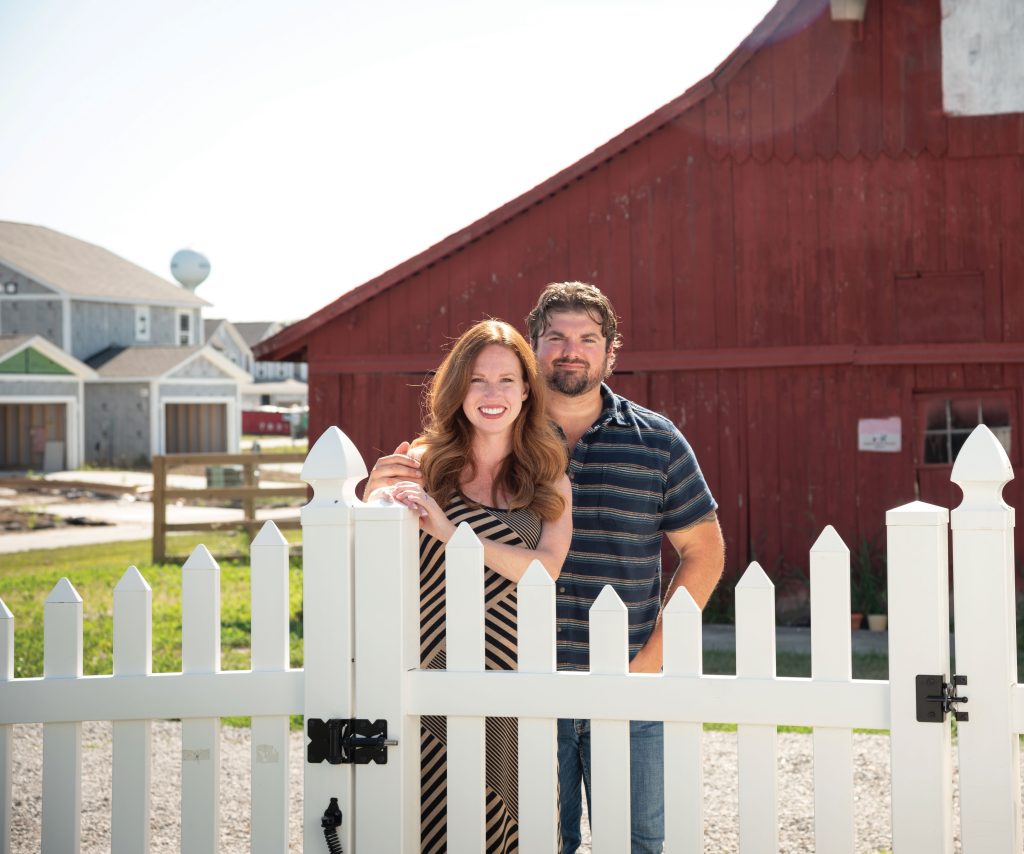
By Richard G. Biever
When Robyn and Jason Thompson tied the knot in 1998, she warned him the rope was attached to more than just her. “She told me when I married her, I married the land,” Jason said. “And she wasn’t lying.”
That land is a 70-acre farm in eastern Morgan County. Once covering “half the township,” the grain and livestock farm has been in Robyn’s family for 175 years. It was maintained and passed down through seven generations on her maternal side.
Robyn knew from an early age she would eventually have to move home. “This is just who I am,” she told him, “and this is the life I want to have. I want to raise my children out there, and I want to make my life there.”
For the past 12 years, the Thompsons, both 46, and their two children, now 21 and 18, have lived on the land in the farmhouse Robyn grew up in. They moved in and became the farm’s chief caretakers when Robyn’s mother moved to Brown County (Robyn’s parents had divorced years earlier).
But Robyn and Jason aren’t farmers. And neither is her only sibling, younger brother Bryan Bunton. Neither were Robyn and Bryan’s parents. So, ever since their grandparents were well into their 80s and no longer able to work the land, the fields were leased to area farmers. And in those 20-some years after her grandfather retired, the farm’s barns and outbuildings sat empty and devoid of the life and livelihood they once supported.
Venerable barns need to be needed, need to have purpose, just as people do, or they quickly start declining, too. That’s what happened to the family’s English bank barn that dates to 1874.
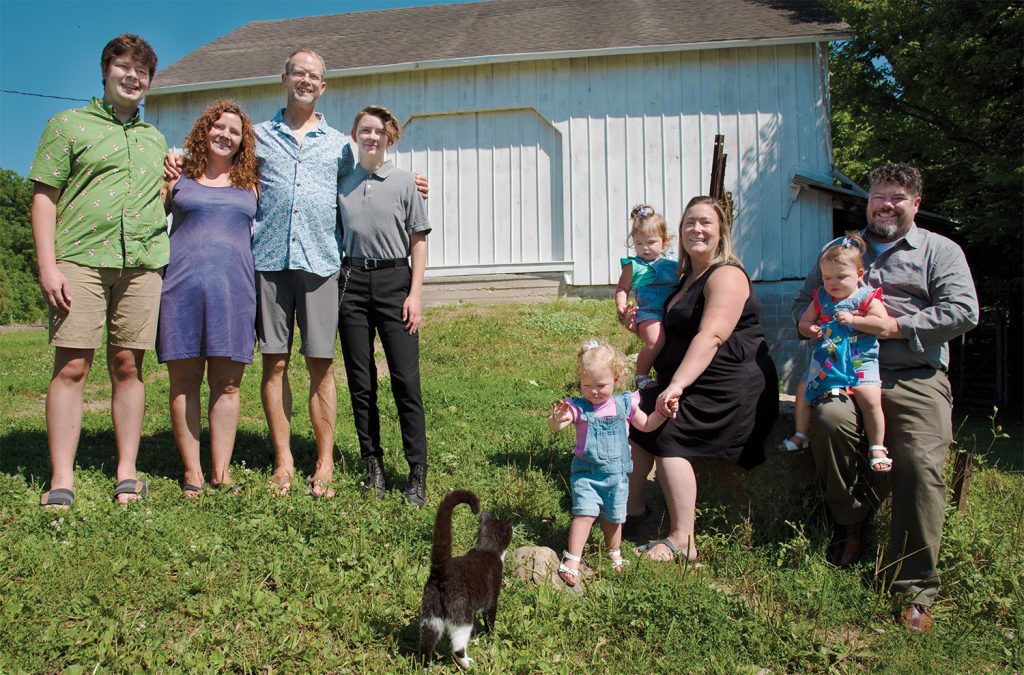
“I just I couldn’t handle it. The barn had Creeping Jenny all over. It just looked awful,” she said. Upon moving home, they found the roof had begun leaking, the concrete center aisle had cracked and was crumbling, a foundation wall caved in, groundhogs were everywhere. “I was very close to my grandfather. I spent a lot of time up there in that barn. I took care of the horses. It just made my heart sick to see it in that condition.”
Soon after, the Thompsons turned to programs offered by Indiana historical preservation groups to learn what they could do to restore and maintain the remainder of the farm. And they joined a newly formed organization dedicated solely to supporting the preservation of Indiana’s historic barns like theirs — The Indiana Barn Foundation.
Building a foundation
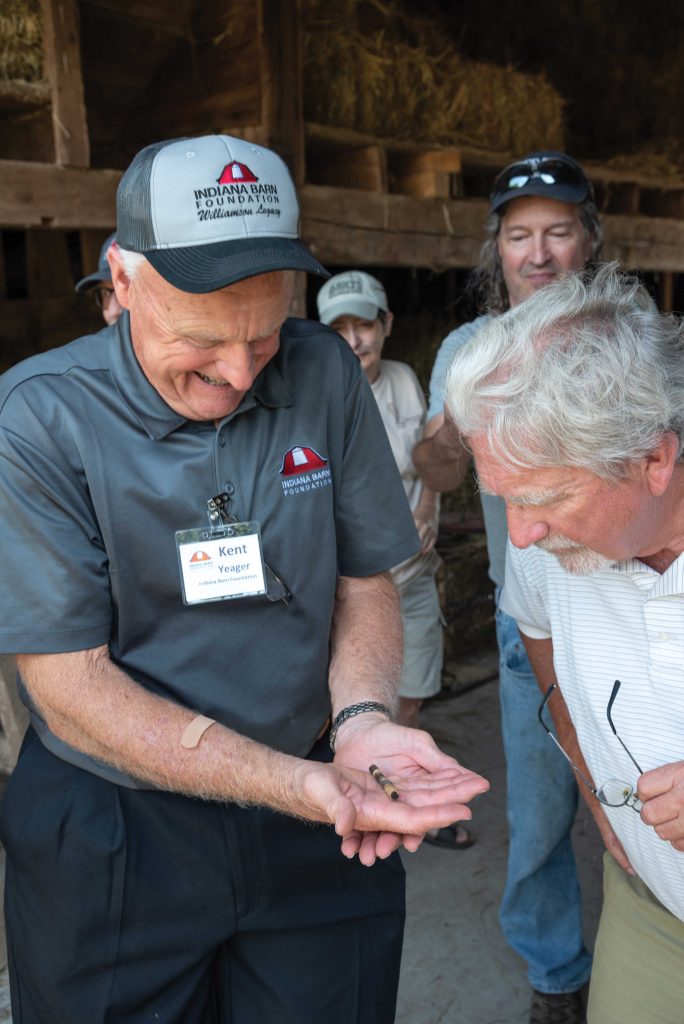
The Indiana Barn Foundation was established in 2013 and is an eclectic group of farmers, rural residents, agricultural folks, and those who just love those iconic fixtures of Indiana’s family farming heritage.
Its goal is to support folks wanting to restore and preserve heritage barns. In doing so, they preserve a major piece of the story of Indiana’s agricultural history — its implements, its structures, and its people — that made Indiana one of the most productive agricultural states in the nation despite being the smallest state by area west of Appalachia.
“A lot of people would tell you, to see a classic old barn still standing in the countryside just looks beautiful,” said Kent Yeager, president of IBF. “But to me, it’s more about the history and heritage that’s involved in these buildings … being built from natural resources that were right there locally. And the fact that a lot of these were built when there wasn’t much in the way of tools. It was hammers and chisels. It took real craftsmanship to build these things.”
Yeager, 70, said the construction methods — hand-hewing, drilling holes, and setting giant timbers without cranes and electricity — and the little variations each local farmer and carpenter incorporated still fascinate him. And then to frame and raise these massive structures, he said, took a whole community coming together. But these castles of the countryside began to outlive their usefulness by the mid-1900s. Changes in agriculture brought larger and larger commercial farms. The machinery used to work them grew with the acreage and literally outgrew the wooden structures.
More practical and frugal than sentimental, many farmers began bulldozing and burning the outdated structures rather than continuously pay the insurance and taxes levied on them. Many barns were crowded out by suburban development. Others were dismantled for the weathered wood siding and huge timbers that were sold off for rustic accents or structural elements for new custom homes. Others were allowed to slowly crumble until, like some Gothic ruin, they were reclaimed by the earth.
At the start of the 21st century, an estimated 30,000 barns still stood across Indiana’s countryside. A third of those disappeared by 2010, and more disappear each year.
To support preservation projects, the Foundation awards annual grants for barns in most urgent need of repair. A year ago, IBF also established the Mauri Williamson Legacy Endowment to create an ongoing funding source for itself for grants, educational efforts, and technical assistance.
Williamson, who died in 2017 at age 91, devoted his life to telling and preserving Indiana’s agricultural history as a longtime leader of Purdue University’s Agricultural Alumni Association and founder of the State Fair’s Pioneer Village. He was also the catalyst for the IBF, Yeager said.
Around the time of IBF’s beginning, many of the same individuals involved in the foundation helped encourage the Indiana General Assembly to adopt a property tax deduction for heritage barns. By removing the assessed tax, the hope was more barns would be saved.
IBF has seen dramatic growth in interest and membership in the past couple of years. For most of its short existence, its membership was around 200. That number doubled to 400 in the past year, as has applications for grants. “This year, we had a sea change in grant applications,” Yeager said. “It makes our task much more difficult, twice as difficult, in determining who was going to get a grant.”
Staying true
Andy Bell drove from his home in Whitestown in Boone County down to Martinsville for IBF’s annual meeting and barn tour in July. It was the first IBF event he’d participated in since joining a year ago. Unlike Robyn with her deep roots to her farm, Andy, 36, and his wife Gwen, 35, had no family attachment to their acre and a half and barns until they bought the lot in 2021. Along with the Queen Anne/Victorian style farmhouse and garage came two old barns they didn’t know what they’d do with.
In another lifetime, the house and barns had been the base of a 120-acre multi-generational family farm. Located on the main county road north out of Whitestown, the farm fanned out west and north. Andy said a prominent area farmer purchased the entire farm from the original family years earlier and had maintained the barns and updated the house while keeping its old character.
In the past decade, Whitestown has become a suburban boomtown. Fields where tractors turned the soil just a few years ago now bustle with bulldozers and new construction. South toward Indianapolis are new retail centers, professional buildings, restaurants, and more.
That farm on the north end of Whitestown was also sold to a developer. A gridded sea of curving streets and cul-de-sacs, roundabouts, and retention ponds, prepared the way for new homes that are sprouting up like young shoots of corn in spring — except for the lot with the Queen Anne house and barns. That lot, the landowner hoped to sell to a family that would preserve its integrity. He found that buyer with the Bells.
“We refuse the whole ‘cookie-cutter subdivision’ thing,” said Andy. “It is fine, to each their own, but we just like things that have a little more story, some charm behind it.”
Andy, who works in technology in downtown Indianapolis, and Gwen, an administrator with Noblesville schools, loved the unique circa-1900 two-story home with the wrap-around porch and asymmetrical gables when they first saw it. It had exposed dark hardwoods Gwen especially loved and antique charm. It had the large lot. It had updated electrical wiring, kitchen, and bathrooms. And the price was right — selling just before the real estate market went bonkers. But it had sat on the market for 300 days, so they were a little suspicious.
“What’s wrong with it? Is it haunted? Is it on a burial ground? Is it gonna implode? …” Andy said.
“Is there something horribly wrong with the updates? People aren’t wanting to take the risk?” Gwen added.
They waited for the inspection results.The inspector’s only comment: “It’s an old house.It will have some issues.” But he noted no corners were cut on the updates; everything was done well. The only mark the real estate agent said it had against it was the open farmland around it would soon become suburban neighborhoods.
That didn’t faze the Bells. In fact, it meant the children they hoped to have — the first, Henry Preston, expected to arrive in mid-August (just as this issue went to press) — would have a neighborhood of other kids to play with and a big yard and barns they could all hang out in. And with Whitestown’s growing amenities, they could see themselves putting down deep roots.
“Once we bought the house, I was tinkering around in the barn,” noted Andy. “I was like, ‘I don’t know what I’m doing. This is awesome, but there’s a lot going on here.’” That’s when he found the Indiana Barn Foundation online and joined. “I want to restore it, I want to keep its original charm, but I want to make it functional.”
The two have toyed with the idea of someday opening a hybrid coffee shop/antiques shop in the big barn or creating studio space for Gwen who was an art teacher before becoming an administrator. She paints and creates pottery and is a classically trained musician on violin and piano. They also envision using the loft as office space. But with the cost involved and the baby on the way, they decided those plans will have to wait. In the meantime, they plan to clean it up and make sure it remains sound.
That’s what brought Andy to IBF’s annual meeting where he learned more about his barn and made contacts with other barn owners. “You can tell they’re just such advocates for the restoration and the history and just being stewards of old barns. I’m obsessed with our big barn. But it’s such a tall order.”
The Bells intend to keep as much of the original look and feel as they can to their house and barns. “That’s a recurring theme,” Andy said. “We just want to stay true to the land.”
Coming home
Robyn Thompson’s outlook on staying true to her family’s land improved after attending an Indiana Landmarks Foundation seminar and joining IBF. “I came back with fresh eyes. Our barn was actually better than I thought it was. I felt much more hopeful. We had a plan of attack on how to get it back to its former glory,” she said.
They rid the barn of varmints, made repairs to its structure, added new fencing to the barn lot, and then brought in new tenants — goats. They learned livestock help reduce the freeze-thaw cycle that had damaged the foundation when the barn sat empty. The goats act as a passive mowing system for the barn lot, too. They also added a farm dog — a Great Pyrenees — to protect the goats and keep groundhogs away.
Her brother, Bryan, suggested they plant hay to sell, use as feed for the goats, and store in the lofts to keep them from being empty, another takeaway from the seminars on the care and feeding of an old barn. Robyn has since become IBF’s Morgan County representative, creating a Facebook page and sharing information with others.
For all the love the siblings have for the legacy that has tied them to their family’s land, they agree critical decisions loom on the horizon. The Thompsons will soon be empty nesters, and their children plan to live elsewhere. “We’re still young,” Robyn said. “But we’re starting to feel it. We put that hay up the other day, and we were exhausted. I don’t know that I want to do that much longer.”
Inside the farmhouse hangs a fading yellow and stained photo from the 1890s of her ancestors posed in front of the 1874 barn. The ancestors, staring out from the past, seem to cast a stern and stony sideways glance whenever she thinks of moving on. “I cannot look at that photo and not feel some level of guilt,” she said. “They’re so proud. You can feel it in that photo.”
Bryan, who works for a utility in Indianapolis and lives in Greenwood, has just started taking a greater interest in the farm and the family legacy. At 43, he and his wife, Katie, just recently added to the long lineage of girls in the family. They are parents of toddler triplets, Madelyn, Gwendolyn and Evelyn, who are approaching 2. Bryan said he wants his girls to feel at home on the farm. Maybe one of them, or all three, he muses, will carry the farm into the next generation.
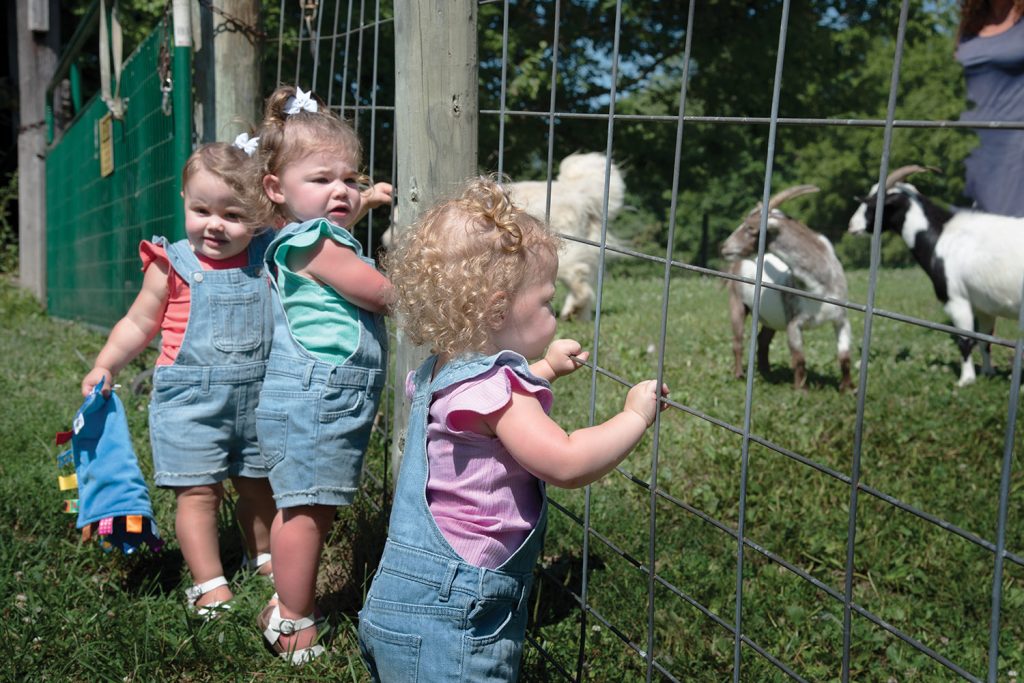
“We’re in suburbia primarily because of the school systems and all that,” he said. “But I want them to have the same experiences I had growing up: being able to run for hours and not see the same thing twice; being able to go play in the creek or in the barn lofts. It would be a lot easier to just pack up, sell everything off. But there’s so much family history here that it just wouldn’t feel right. This is still always home.”
Whether a historic barn stays in a family and continues supporting the working farm, or is in the hands of a new keeper and finds a new or different lease on life, the Indiana Barn Foundation is there to help. IBF makes sure a barn has a place and means to continue preserving Indiana’s agricultural heritage, telling stories of families and farms of the past, and making memories for future generations.
RICHARD G. BIEVER is senior editor of Indiana Connection.
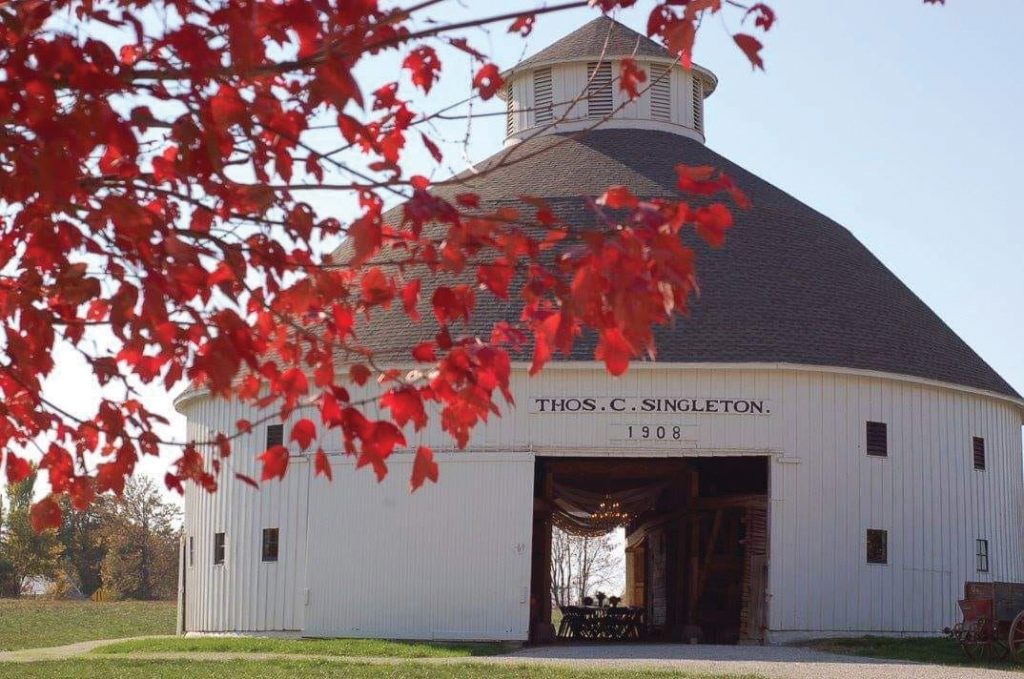
Indiana Barn Foundation
The Indiana Barn Foundation, a 501(c)(3) organization, is a network of barn enthusiasts supporting barn preservation. Through its associations with National Barn Alliance, Indiana Landmarks, and barn experts, IBF offers preservation workshops, barn tours, educational and grant opportunities, updates and info on relevant legislation, and a quarterly newsletter.
To join or learn more information, go to: www.IndianaBarns.org, or on Facebook.com/IndianaBarns; email: info@indianabarns.org; or write to the Indiana Barn Foundation, 1201 Central Ave., Indianapolis, IN 46202.
IBF Barn Tour fundraiser
Daviess County is the site of Indiana Barn Foundation’s 2022 Barn Tour, Saturday, Sept. 24, 10 a.m.-4 p.m.
Join barn enthusiasts in touring a variety of historic barns, including the 1908 T.C. Singleton Round Barn which serves as host. See the stunning craftsmanship, hear about their histories, and learn from a preservation expert how to assess a barn’s rehabilitation needs.
Make it a weekend experience by attending a special event on Sept. 23, featuring dinner inside the Singleton Round Barn and a presentation by award winning author and photographer John Hanou.
For tickets: visit IndianaBarns.org; or Facebook.com/IndianaBarns.



